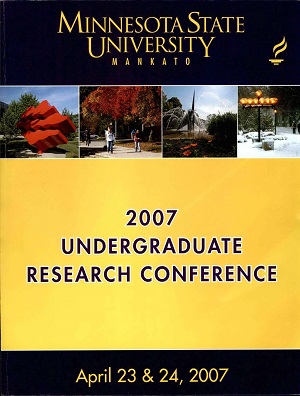Reflections on Canvas: Caravaggio and the Development of Optical Style
Location
CSU 203
Start Date
23-4-2007 8:15 AM
End Date
23-4-2007 9:45 AM
Student's Major
Art
Student's College
Arts and Humanities
Mentor's Name
Curt Germundson
Mentor's Department
Art
Mentor's College
Arts and Humanities
Description
At the height of his career. Baroque painter Michaelangelo de Mersi Caravaggio was revered for his ability to foster a heightened sense of realism never before seen upon the canvas. However, as recent scholarship and a renewed interest in the history of artistic methodology reveal, the artist may have utilized optical devices such as a single lens to project reflections of his subjects upon the canvas. Due to the limitations of such devices, spacial discontinuity and unnatural proportion are just two of the discrepancies which have affected the realism and overall unity of his artwork. Caravaggio worked with naturalism in mind and therefore would have used the optical device as an aid in heightening the realism of his work. While certain aspects of his paintings such as facial expression and light remained raw and naturalistic the overall unity of the works were compromised, consequentially creating fragmented spaces with subjects who were emotionally and physically disengaged from each other. These aspects can be attributed to the use of the lens, which was only capable of reflecting one figure at a time. Permeating Caravaggio's canvases these discrepancies also influenced his followers, the Caravaggisti. With noticeable visual elements recalling the effects,of Caravaggio's optical device, his followers have adopted these discrepancies as stylistic traits within their paintings. This paper will examine Caravaggio's alleged use of optical devices and the subsequent effects which have impacted his followers.
Reflections on Canvas: Caravaggio and the Development of Optical Style
CSU 203
At the height of his career. Baroque painter Michaelangelo de Mersi Caravaggio was revered for his ability to foster a heightened sense of realism never before seen upon the canvas. However, as recent scholarship and a renewed interest in the history of artistic methodology reveal, the artist may have utilized optical devices such as a single lens to project reflections of his subjects upon the canvas. Due to the limitations of such devices, spacial discontinuity and unnatural proportion are just two of the discrepancies which have affected the realism and overall unity of his artwork. Caravaggio worked with naturalism in mind and therefore would have used the optical device as an aid in heightening the realism of his work. While certain aspects of his paintings such as facial expression and light remained raw and naturalistic the overall unity of the works were compromised, consequentially creating fragmented spaces with subjects who were emotionally and physically disengaged from each other. These aspects can be attributed to the use of the lens, which was only capable of reflecting one figure at a time. Permeating Caravaggio's canvases these discrepancies also influenced his followers, the Caravaggisti. With noticeable visual elements recalling the effects,of Caravaggio's optical device, his followers have adopted these discrepancies as stylistic traits within their paintings. This paper will examine Caravaggio's alleged use of optical devices and the subsequent effects which have impacted his followers.
Recommended Citation
Harper, Eleanor Rae. "Reflections on Canvas: Caravaggio and the Development of Optical Style." Undergraduate Research Symposium, Mankato, MN, April 23, 2007.
https://cornerstone.lib.mnsu.edu/urs/2007/oral-session-02/4



